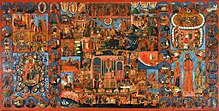A proskynetarion (Greek προσκυνητάριον, plural proskynetaria; from προσκύνησις, proskynesis, lit. 'kiss towards something') is a term suggesting worship and reverence, which has several concrete applications.

Islamic cultic place or object
editAs a rare Byzantine term meaning "oratory" or "place of worship", it was used for Islamic cultic places or objects.[1]
Monumental icon
edit"Proskynetarion" can mean a monumental icon of the Eastern Orthodox Church usually depicting Christ, the Virgin Mary, or the patron saint of a church. Proskynetaria were usually made of mosaic or fresco in a marble frame and placed on the piers separating the parts of a templon in a Byzantine church, though proskynetaria of patron saints were often in the narthex or on the nave walls.[citation needed]
Pilgrim's guide to the Holy Land
editProskynetaria were also a genre of Orthodox Christian pilgrim guides to the Holy Land, which appeared in the mid-17th century and flourished during the 18th.[2] The usually small-format, accessibly written books served as practical itinerary suggestions, with descriptions of the pilgrimage sites in Palestine.[2] They were authored either by pilgrims, or by writers who recycled material from existing works.[2]
Souvenir icon for Holy Land pilgrims
editLarge icons painted on canvas and sold as souvenirs to Orthodox Christian pilgrims to the Holy Land.[3] They depicted a topographic overview of Christian holy sites, with the walled city of Jerusalem and the Church of the Holy Sepulchre placed at the centre.[3] They represent the most visually attractive genre of the flourishing local icon industry from the late Ottoman period, 19th-century artists from Palestine dominating the pilgrim souvenir production also in Egypt and Syria.[3] Possibly first created in the second half of the 17th century, the oldest specimen preserved among the several hundred surviving examples is from 1704.[3] In the first half of the 19th century the pattern changed, replacing the topographic depiction with a patchwork of icons, still centred around the Church of the Holy Sepulchre and the Holy Fire ceremony, but surrounded by scenes from the life of Christ and the Akathistos Hymn of the Theotokos.[3] Cheap prints rang death knell of the painted proskynetaria by the end the 19th century.[3]
Wayside proskynetaria
editReferences
edit- ^ Proskynetarion in The Oxford Dictionary of Byzantium, via OxfordReference.com. Accessed 24 Feb 2021.
- ^ a b c Chrysanthus of Bursa. Proskynetarion [Pilgrim's Guide of Jerusalem] and Palestine. Vienna, Schrämbl, 1807. From Travelogues website, Aikaterini Laskaridis Foundation. Accessed 24 Feb 2021.
- ^ a b c d e f Immerzeel, Mat. Souvenirs of the Holy Land. The Production of Proskynetaria in Jerusalem (PDF). p. 40. Retrieved 24 February 2021.
{{cite book}}:|work=ignored (help)
Further reading
editArad, Pnina (2018). "Landscape and Iconicity: "Proskynetaria" of the Holy Land from the Ottoman Period". The Art Bulletin. 100 (4): 62–80. doi:10.1080/00043079.2018.1464359. ISSN 0004-3079. JSTOR 44972822. S2CID 192727550.